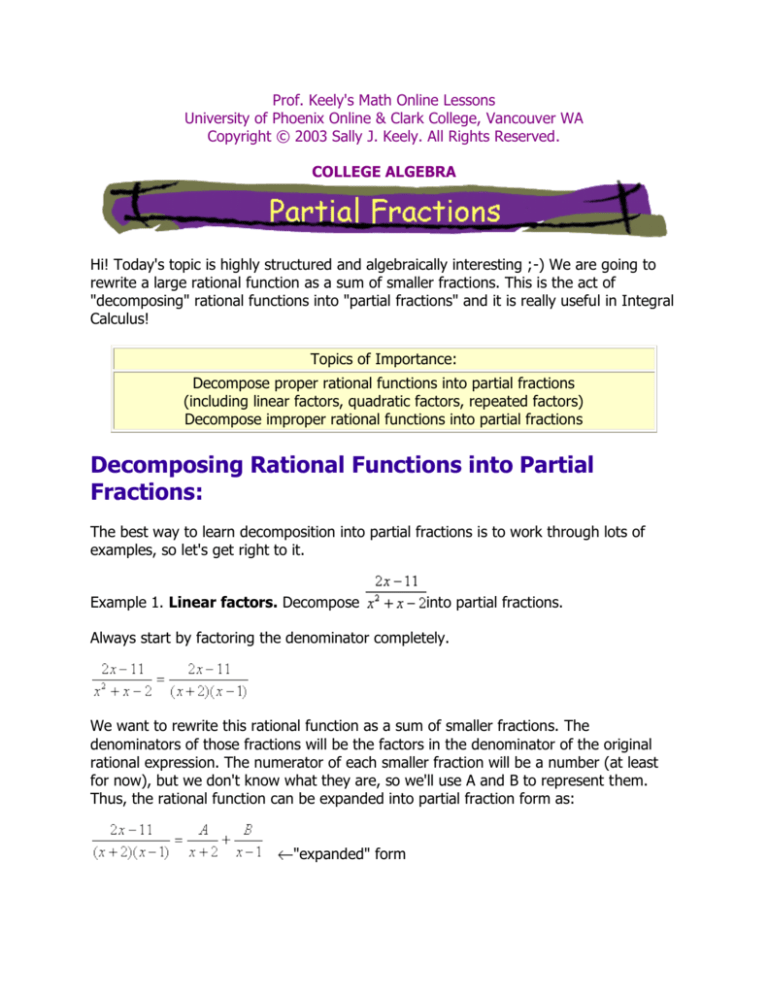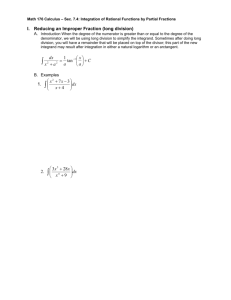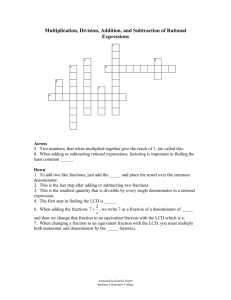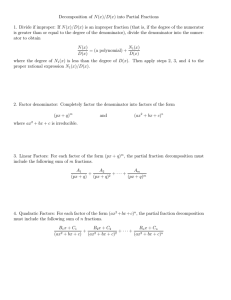
Prof. Keely's Math Online Lessons
University of Phoenix Online & Clark College, Vancouver WA
Copyright © 2003 Sally J. Keely. All Rights Reserved.
COLLEGE ALGEBRA
Hi! Today's topic is highly structured and algebraically interesting ;-) We are going to
rewrite a large rational function as a sum of smaller fractions. This is the act of
"decomposing" rational functions into "partial fractions" and it is really useful in Integral
Calculus!
Topics of Importance:
Decompose proper rational functions into partial fractions
(including linear factors, quadratic factors, repeated factors)
Decompose improper rational functions into partial fractions
Decomposing Rational Functions into Partial
Fractions:
The best way to learn decomposition into partial fractions is to work through lots of
examples, so let's get right to it.
Example 1. Linear factors. Decompose
into partial fractions.
Always start by factoring the denominator completely.
We want to rewrite this rational function as a sum of smaller fractions. The
denominators of those fractions will be the factors in the denominator of the original
rational expression. The numerator of each smaller fraction will be a number (at least
for now), but we don't know what they are, so we'll use A and B to represent them.
Thus, the rational function can be expanded into partial fraction form as:
"expanded" form
Next, multiply both sides of this equation by the LCD (x+2)(x-1) to eliminate the
denominators leaving,
2x-11 = A(x-1) + B(x+2)
We need to solve for A and B. One way to do this is to pick "nifty x's" that would make
either the A or the B disappear. For instance, if we let x=1 and substitute it in for x
throughout the equation we get,
2(1)-11 = A(1-1) + B(1+2)
2-11 = 0A + 3B
-9 = 3B
B = -3
See how the A disappears and we are able to solve for B? Now do this again picking a
different "nifty x" ... this time one that would make the B disappear. Yes, let x=-2 to
get,
2(-2)-11 = A(-2-1) + B(-2+2)
-4-11 = -3A + 0B
-15 = -3A
A=5
Cool! Substituting these values back into the expanded form of the rational function
gives our final decomposed form:
final "decomposed" form
There, we have written the original rational function as a sum/difference of two smaller
fractions, thus we have decomposed the original rational function into partial fractions.
If you want to check this answer, combine 5/(x+2)-3/(x-1) by building them up to each
have the LCD and simplifying to see if you get the original rational expression.
Example 2. Linear Factors. Decompose
into partial fractions.
First factor the denominator completely,
Then expand into partial fraction form,
Multiply through by the LCD x(x-2)(x+2) to get,
3x2+7x-2 = A(x-2)(x+2) + Bx(x+2) + Cx(x-2)
Pick "nifty x's", substitute them in, and solve for A, B, and C:
Let x=2 ... 3(2)2+7(2)-2 = A(0)(4) + B(2)(4) + C(2)(0)
24 = 8B
B=3
2
Let x=-2 ... 3(-2) +7(-2)-2 = A(-4)(0) + B(-2)(0) + C(-2)(-4)
-4 = 8C
C = -½
Let x=0 ... 3(0)2+7(0)-2 = A(-2)(2) + B(0)(2) + C(0)(-2)
-2 = -4A
A=½
Finally, substitute A, B, and C back into the expanded form. Here we may want to
simplify to avoid leaving compound fractions in the final answer.
Example 3. Repeated linear factors. Decompose
into partial fractions.
The denominator is already factored, but notice that it has repeated factors. When
expanding repeated factors into partial fractions, we must include a fraction with each
power of the factor. In this case it is ( )3 so we need a fraction with ( )1 in the
denominator, a fraction with ( )2 in the denominator, and a fraction with ( )3 in the
denominator. Here then is the expansion:
Multiplying through by the LCD (x-2)3 gives,
2x2-9x = A(x-2)2 + B(x-2) + C
Pick 2 as our "nifty x", substitute it in, and solve:
Let x=2 ... 2(2)2-9(2) = A(0)2 + B(0) + C
C = -10
Uh oh, that is the only possible "nifty x". Now what? How can we solve for A and B? We
need a second method for finding these constants. Return to,
2x2-9x = A(x-2)2 + B(x-2) + C
FOIL and simplify on the right hand side:
2x2-9x = A(x-2)(x-2) + B(x-2) + C
2x2-9x = A(x2-4x+4) + B(x-2) + C
2x2-9x = Ax2-4Ax+4A + Bx-2B + C
2x2-9x = Ax2 + (-4A+B)x + (4A-2B+C)
Now, here is a neat trick. If the polynomial on the left is equal to the polynomial on the
right, then the coefficient of the x2-term on the left must equal the coefficient of the x 2term on the right; the coefficient of the x-term on the left must equal the coefficient of
the x-term on the right, and the constant term on the left must equal the constant term
on the right. So, equate them!
coefficients of x2-terms
2=A
coefficients of x-terms
-9 = -4A+B
-9 = -4(2)+B
B = -1
constant terms
0 = 4A-2B+C (But we needn't solve this equation because at this
point in this problem, we have already found the A, B, and C.)
So, our final answer is,
Thus, if the "nifty x" method doesn't produce all the constants, resort to the "equating
coefficients" method. With practice, you really won't need to do the FOIL and simplify
step in most cases. For instance, in example 3 we had 2x 2-9x = A(x-2)2 + B(x-2) + C.
You can easily look at this and tell that the only x 2 term on the right will be Ax2 (so right
away we have A=2). It is also easy to see without FOILing that the constant terms on
the right will be 4A-2B+C. Given that we had already found C=-10 and A=2, we can
plug these into the equation obtained by equating constant terms from both sides of
the equation to get 0=4A-2B+C
0=4(2)-2B+(-10)
B=-1. Usually working with
just the highest degree term and/or the constant term will enable you to complete the
identification of all the unknown letters.
Example 4. Quadratic factors. Decompose
into partial fractions.
Start by factoring the denominator,
Next we need to write the expansion. But, this expansion will be a bit different since we
have a quadratic factor (well, quadratic irreducible in the eals). The term in the
numerator of each fraction in the expansion is actually one degree less than the factor
in the denominator. When we had only linear factors, one degree less gave us
constants in the numerators. But when you have a quadratic factor, one degree less
means we need a linear term in the numerator. So above the x 2+1 quadratic factor we
need the linear factor Bx+C as shown in the expansion:
Multiplying through by the LCD (x+3)(x2+1) gives,
4x2+x-3 = A(x2+1) + (Bx+C)(x+3)
Pick -3 as our "nifty x", substitute it in, and solve:
Let x=-3 ... 4(-3)2+(-3)-3 = A((-3)2+1) + (B(-3)+C)(-3+3)
30 = 10A
A=3
Since there is no eal number that can be substituted in for x to make x2+1 zero out,
we must resort to the "equate coefficients" method for finding B and C. Looking at
4x2+x-3 = A(x2+1) + (Bx+C)(x+3) we can equate coefficients of the leading term and
equate constants (those two terms are the easiest to "see" without having to FOIL and
simplify first).
x2-terms
4 = A+B
4 = 3+B
B=1
constant terms
-3 = A+3C
-3 = 3+3C
C = -2
Substituting these values in for A, B, and C gives the final decomposed form,
A bit more on this "one degree less" in the numerator rule. Suppose we had had a
fourth-degree factor (irreducible in ) in the denominator such as x4+16, then its
numerator in the expansion would have to have been one degree less, i.e. a cubic such
as Ax3+Bx2+Cx+D. Does that make sense?
Also, look back at example 3. One of the fractions in the expansion was C/(x-2)3 ... but
shouldn't we have used a quadratic term in the numerator since the denominator was
(if FOILed out) cubic? No! CAUTION: The rule is to use an expression in the numerator
that is one degree less than the factor in the denominator, not the simplified expression
in the denominator. So, you use an expression that is one degree less than the inside of
the ( ) in the denominator.
Example 5. Quadratic factors.Decompose
into partial fractions.
As always, factor the denominator first,
Which (remembering to use linear expressions in the numerators of the quadratic
factors) expands to,
Multiplying through by the LCD (x2+4)(x2+1) gives,
5x3-x2+14x-1 = (Ax+B)(x2+1) + (Cx+D)(x2+4)
Since both factors only have non- eal roots, we can't use the "nifty x" method at all
(why not?) and must resort to the "equate coefficients" method.
x3-terms
5 = A+C
2
x -terms
-1 = B+D
x-terms
14 = A+4C
constant terms
-1 = B+4D
Essentially what we have now is a 4x4 linear system. We can solve it algebraically, but
if you have a calculator handy that has a linear system solver, take advantage of it!
(See my MOL Calculator Guide: Linear Systems at www.integreat.ca/MOL/CG/3.2_syssimult.htm for information about how to a TI calculator's linear solver.) To solve
electronically the system will likely need to be rewritten as:
1A
0A
1A
0A
+
+
+
+
0B
1B
0B
1B
+
+
+
+
1C
0C
4C
0C
+
+
+
+
0D
1D
0D
4D
=
=
=
=
5
-1
14
-1
The solution should yield A=2, B=-1, C=3, D=0. Plugging those into the expansion
gives the final answer,
Example 6. Repeated quadratic factors. Write
expanded into
general partial fraction form. You do not need to perform the full decomposition.
The denominator is factored completely, so we are ready to expand.
Hmmm, why does the x2 term not have a numerator of Bx+C? Because x2 should really
be thought of as (x)2 thus the stuff inside the parentheses is a linear factor so we only
need a constant in its numerator. Similarly the x 3 term is really (x)3 so again we have a
linear factor inside the parentheses requiring only a constant in its numerator.
CAUTION!
LQ 3.3.1
Try this Lesson Question!
Discuss the solution with others :)
Is there a way to predict how many fractions the partial
fraction expansion is going to have? Is there a way to
predict how many letters will be needed in the partial
fraction expansion? Look for patterns in example 6 to
discover the answers to these questions :)
Decomposing Improper Rational Functions into
Partial Fractions:
So far all of our examples have been proper fractions, but if the original rational
function is an improper fraction (meaning that the degree of the numerator is greater
than or equal to the degree of the denominator) then you must perform long division
before attempting the partial fraction decomposition.
Example 7. Improper fraction. Decompose
into partial fractions.
Since the degree of the numerator is greater than or equal to the degree of the
denominator we must start by performing long division.
Thus the original fraction can be rewritten as,
The fraction obtained from the remainder is the only part that needs to be decomposed
into partial fractions.
x+2 = A(2x+1) + Bx
Let x=-½ ... -½+2 = A(0) + B(-½)
Let x=0 ... 0+2 = A(2*0+1) + B(0)
3/2 = -½B
A=2
B = -3
Thus the final answer is,
I hope you have enjoyed these examples and had fun with the algebra. You will find partial
fraction decomposition quite handy in Integral Calculus. It is FAR easier to integrate the partial
fractions than to integrate the original big old fraction. I bet you can't wait to get there!! So
much fun awaits you in Calculus :)
Additional Resources: www.integreat.ca/MOL/LINKS/calg.htm#03.3







